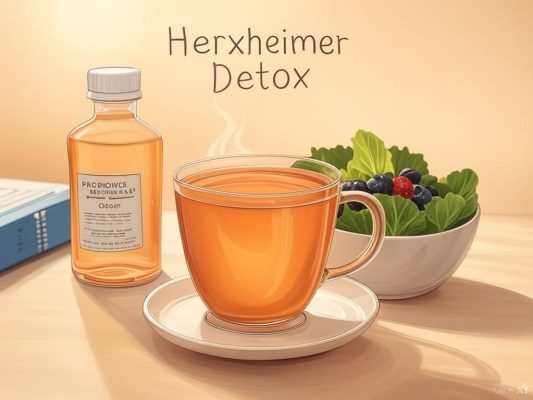
Written by Dr. Diane Mueller
Have you ever felt worse before feeling better during a Lyme Disease Treatment? That’s likely the Herxheimer reaction—a temporary but uncomfortable response as your body works to eliminate toxins. This reaction happens when your liver and kidneys release stored toxins faster than your body can process, leading to fatigue, headaches, or nausea. While it might feel like a setback, it’s a sign your body is actively cleansing itself.
The Herxheimer reaction, or “herx,” is a temporary response where the body releases toxins faster than it can eliminate, often occurring during detox or antimicrobial treatments. Symptoms like fatigue, headaches, and nausea indicate the body is cleansing.
Common symptoms include fatigue, headaches, body aches, skin rashes, and digestive issues. These are signs of the body’s immune response to toxins released during detoxification.
Causes: The reaction is triggered by bacterial die-off, immune system activation, and toxin release. It’s commonly seen during treatments for infections like Lyme disease, where pathogens release endotoxins into the bloodstream.
Management Strategies: To reduce discomfort, stay hydrated, support liver function, adjust treatment intensity, and prioritize rest. Natural remedies like heat therapy, anti-inflammatory foods, and supplements (e.g., binders and probiotics) can help alleviate symptoms.
A Herxheimer reaction typically lasts 1-7 days but can extend to weeks in severe cases. The duration depends on factors such as infection severity, treatment intensity, and individual detoxification capacity.

A Herxheimer reaction, often called a “herx,” occurs when the body releases toxins faster than it can eliminate. This reaction is commonly observed during detoxification, particularly when treating infections like Lyme disease or co-infections. As harmful bacteria, viruses, or stored toxins are broken down, they release toxins into the bloodstream, triggering an immune response.
A Herxheimer reaction, often called a “herx,” occurs when the body releases toxins faster than it can eliminate. This reaction is commonly observed during detoxification, particularly when treating infections like Lyme disease or co-infections. As harmful bacteria, viruses, or stored toxins are broken down, they release toxins into the bloodstream, triggering an immune response.
Symptoms of a Herxheimer reaction include fever, chills, nausea, muscle pain, brain fog, and fatigue. Although these symptoms may worsen your condition, they indicate that your body is actively clearing toxins. The reaction is temporary, typically lasting one to three days, though in rare cases, it can persist for several weeks.
During a refresh protocol, your body undergoes two phases. The first phase involves the release of toxins, while the second neutralizes and eliminates them. If the second phase lags behind the first, the buildup of noxious molecules can intensify the Herxheimer reaction. Bowel movements often provide relief, as they help expel toxins more efficiently.
The Herxheimer reaction was first identified in patients undergoing antibiotic treatment for infections. As antibiotics kill off pathogens, the immune system reacts to the sudden influx of endotoxins, causing inflammation and flu-like symptoms. While uncomfortable, this response is a natural part of the healing process, signaling that your body is working to restore balance.
A Herxheimer reaction, often called a “herx,” occurs when the body releases toxins faster than it can eliminate. This temporary response is typical during detoxification, especially when treating infections like Lyme disease or co-infections. Below are the most frequently reported symptoms.
Fatigue is a hallmark symptom of a Herxheimer reaction. Your body expends significant energy fighting pathogens and processing toxins, leaving you feeling drained. This exhaustion often accompanies a general sense of weakness, overwhelming even simple tasks. In some cases, fatigue may persist for several days as your immune system works to restore balance.
Headaches are a common complaint during a herx, caused by releasing toxins and the resulting immune response. These headaches can range from mild to severe and may feel similar to tension or migraine headaches. Body aches, including muscle and joint pain, are also prevalent. As your immune system breaks down harmful bacteria, inflammation increases, leading to discomfort in various parts of your body.
When your primary detoxification systems are overwhelmed, your skin often acts as a secondary elimination pathway. During a heart, you might notice rashes, breakouts, or worsening skin conditions like eczema or psoriasis. These reactions occur as toxins are expelled through the skin, and they typically subside as your body completes the detoxification process.
Digestive symptoms are another common feature of a Herxheimer reaction. You may experience bloating, nausea, diarrhea, or constipation as your body works to eliminate toxins. These issues arise because the digestive system plays a key role in detoxification. Supporting your gut health with proper hydration and fiber can help alleviate these symptoms and speed up the elimination process.
A “herx reaction” occurs when your body responds to rapidly eliminating harmful microorganisms. This reaction is most commonly triggered during antimicrobial treatments, such as antibiotics or herbal protocols, and is characterized by a temporary worsening of symptoms. Understanding the underlying causes can help you manage and mitigate its effects.
The Herxheimer reaction is primarily caused by the sudden die-off of bacteria, particularly spirochetes like those responsible for Lyme disease and syphilis. Antibiotic or antimicrobial agents kill these bacteria, releasing endotoxins, proteins, and other harmful substances into your bloodstream. This rapid influx of toxins overwhelms your body’s detoxification systems, leading to symptoms such as fever, chills, and muscle pain. The intensity of these symptoms often correlates with the number of bacteria being eliminated and the speed at which they are destroyed.
Your immune system plays a critical role in the Herxheimer reaction. As bacteria die and release toxins, your immune system detects these foreign substances and mounts an inflammatory response. This involves the release of cytokines, such as interleukin-6, interleukin-8, and tumor necrosis factor-alpha, which contribute to the flu-like symptoms you experience. While necessary for clearing toxins, the immune response can exacerbate symptoms like fatigue, headaches, and joint pain. In some cases, this reaction can also trigger skin rashes or worsen existing conditions.
The release of toxins during a Herxheimer reaction is a key driver of its symptoms. When microorganisms like bacteria, fungi, or parasites are destroyed, they release endotoxins into your bloodstream. These toxins can cause systemic inflammation, leading to symptoms such as nausea, brain fog, and respiratory congestion. The severity of the reaction often depends on the type and quantity of toxins released, as well as your body’s ability to process and eliminate them. Supporting your liver and promoting detoxification pathways can help reduce the intensity of these symptoms.

Managing a Herxheimer reaction effectively can make the detoxification process more tolerable. By staying hydrated, supporting liver function, adjusting treatment intensity, and prioritizing rest, you can minimize discomfort while allowing your body to heal.
Stay Hydrated
Proper hydration helps flush out toxins and prevents dehydration caused by fever, sweating, and increased urination. Drink water, electrolyte-rich beverages, or clear fluids like herbal teas and broths. Severe cases may require IV therapy to restore hydration levels.
Support Liver Detoxification
The liver plays a key role in detoxification, so support it with whole, organic foods and liver-friendly options like garlic, dandelion, and milk thistle. Supplements like NAC and glutathione can further enhance detox pathways, reducing the severity of symptoms.
Adjust Treatment Intensity
If symptoms become overwhelming, reduce the dosage or frequency of antimicrobial treatments under medical guidance. Balancing treatment intensity with your body’s detox capacity helps manage reactions without hindering progress.
Prioritize Rest and Sleep
Rest and sleep are essential for recovery, as the body expends energy fighting pathogens and processing toxins. To support detoxification and immune function, create a calming bedtime routine, avoid stimulants, and ensure a comfortable sleep environment.
By implementing these strategies, you can reduce the intensity of Herxheimer reactions and support your body’s natural healing processes.
Managing a Herxheimer reaction during refresh involves strategies that reduce symptoms while supporting the body’s natural healing processes. Natural remedies, including heat therapy, anti-inflammatory foods, and targeted supplements, can help ease discomfort and promote recovery.
Heat therapy, such as dry sauna, steam sauna, or infrared sauna, enhances toxin elimination through sweating. While endotoxins aren’t excreted via sweat, heavy metals and volatile organic compounds (VOCs) can be, reducing the detoxification burden on the liver. This method also alleviates joint and muscle aches, common symptoms of a Herxheimer reaction. Avoid heat therapy if you feel weak, dizzy, or have a fever, which may worsen symptoms or lead to dehydration.
Incorporating anti-inflammatory foods into your diet can help mitigate Herxheimer’s symptoms. They reduce inflammation and support detoxification, whether added to meals or consumed as tea, turmeric, ginger, and cinnamon. Antioxidant-rich foods like green leafy vegetables and dark-colored berries also combat oxidative stress caused by endotoxins. These foods not only ease symptoms but also enhance overall refresh pathways.
Supplements are essential in managing Herxheimer reactions by supporting detoxification and reducing symptom severity.
Binders like activated charcoal from coconut shells absorb toxic byproducts released during microbial die-off. They help ease symptoms by preventing these toxins from recirculating in the bloodstream. Using binders during refresh can significantly reduce the intensity of a Herxheimer reaction.
Probiotics, particularly those with 100 billion CFUs, repopulate the gut with beneficial bacteria, restoring microflora balance and improving digestion. An overgrowth of harmful bacteria, such as Candida or SIBO, can exacerbate Herxheimer symptoms by causing leaky gut and systemic inflammation. Probiotics help counteract these effects, promoting a healthier gut environment.
A Herxheimer reaction, often called a “herx,” typically begins within 24 to 72 hours after starting a treatment or refresh protocol. Symptoms, which can include fever, chills, muscle pain, and fatigue, usually last from a few days to a few weeks. In most cases, the reaction resolves within 3 to 7 days, though the duration can vary depending on individual factors.
The length and intensity of a Herxheimer reaction depend on several variables. These include the severity of the underlying infection, the therapeutic dosages used, and the body’s ability to process and eliminate toxins. Due to their complex nature, conditions like Lyme disease or coinfections often result in longer-lasting reactions. Your overall health, immune system response, and detoxification capacity determine how long the reaction persists.
A Herxheimer reaction is a sign that your body is working hard to eliminate toxins and reestablish “homeostasis” (balance). You may not feel very good, but consider it part of the territory and a potential sign you’re moving forward and detoxing. Stay well-hydrated, support your liver, and adjust your treatment to manage the feeling while in it safely.
Everyone’s experience with a Herxheimer reaction is different. If your symptoms persist or worsen, you’re right not to hesitate to consult a Lyme-literate doctor. You can get through this phase and achieve your health goals with the right strategies and patience.
References:
Belum, G., Belum, V., Arudra, S., & Reddy, B. (2013). The Jarisch-Herxheimer reaction: revisited.. Travel medicine and infectious disease, 11 4, 231-7 . https://doi.org/10.1016/j.tmaid.2013.04.001.
Hendriks, K., Van Etten, R., & Van Wijngaarden, P. (2017). [Fever and hypotension after treatment of syphilis; the Jarisch-Herxheimer reaction].. Nederlands tijdschrift voor geneeskunde, 161, D649 .
Ravi, S., Gandhi, A., Prasad, G., & Shanmugam, S. (2023). Meteoric effect of meropenem: an unrevealed case report on Jarisch Herxheimer reaction. International Journal of Basic & Clinical Pharmacology. https://doi.org/10.18203/2319-2003.ijbcp20233910.
We have helped thousands of
people restore their health
and quality of life by diagnosing
and treating their Lyme Disease.
“Dr. Mueller’s approach to medicine is refreshing! There is only so much you can do with western medicine and in my life I was needing a new approach. By addressing the whole body, nutritional diet factors, environmental factors, blood work, and incorporating ideas I had not previously known, I was able to break through with my conditions. I am not only experiencing less pain in my life, but through the process of healing guided by Dr. Diane Mueller, I am now happy to say I have more consciousness surrounding how I eat, what to eat and when things are appropriate. Living by example Dr. Mueller has a vibrancy that makes you want to learn and know more about your body and overall health. I highly recommend her to anyone looking for new answers, a new approach to health, or in need of freedom from pain and limitations.”
-Storie S.
Kihei, HI
